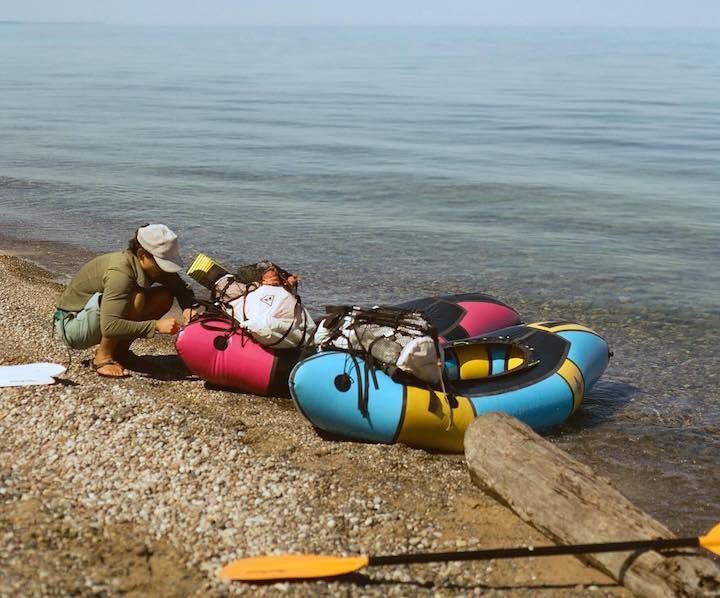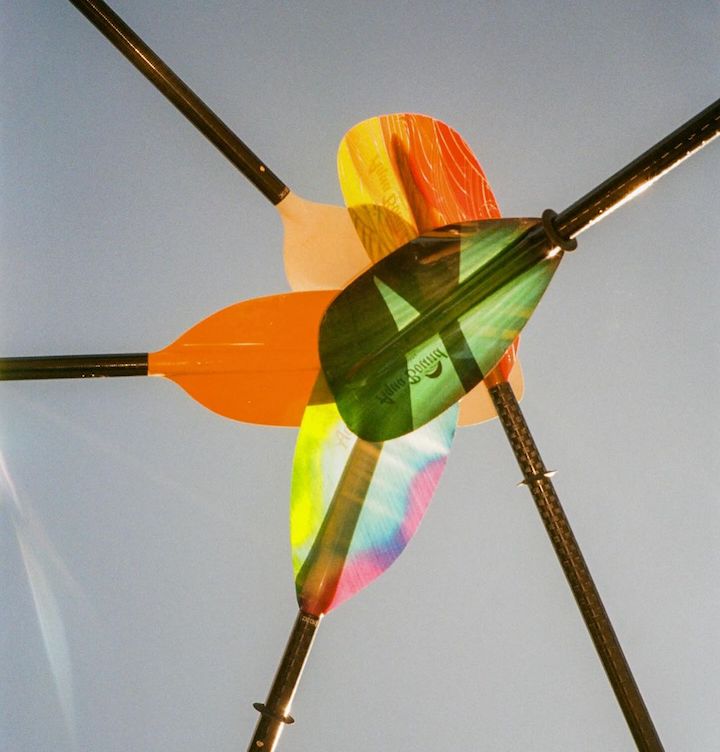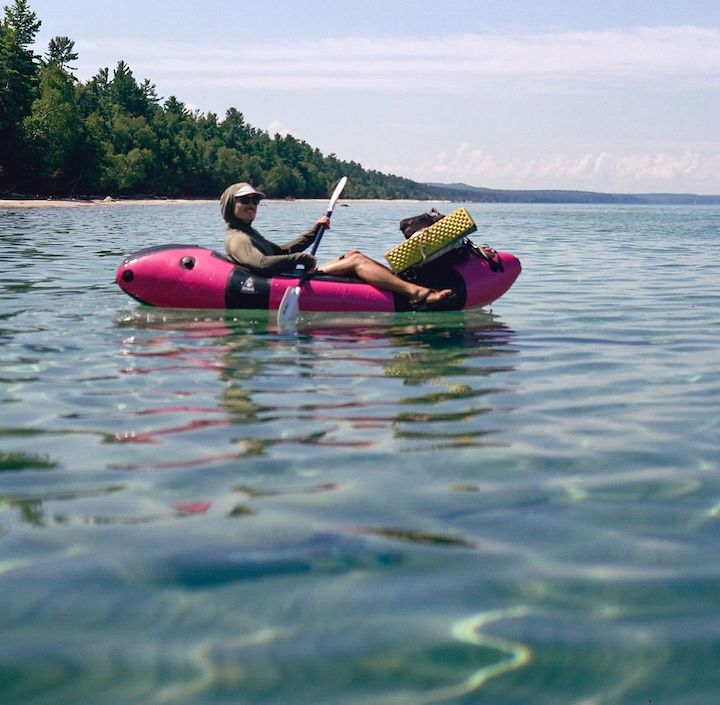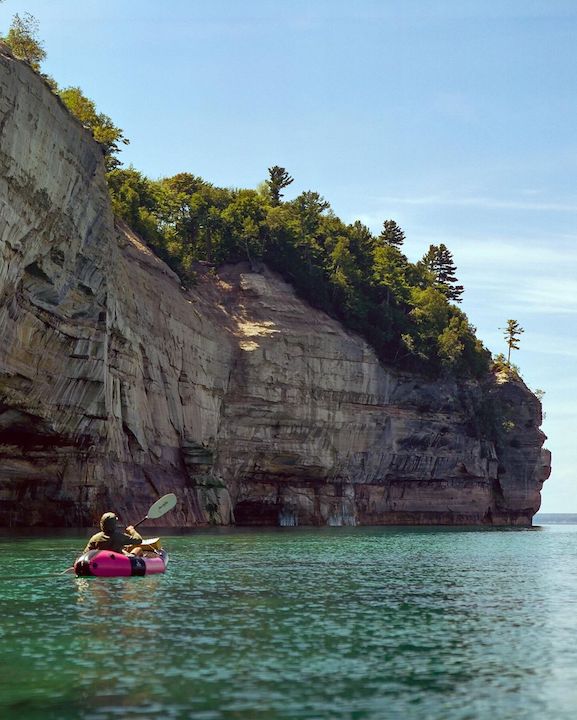New to Packrafting? How to Pack Your Gear
6-minute read + 15-minute video
Our friends MAK and Owen of Bound for Nowhere have put together a super helpful video for those new to packrafting—how to pack your gear for both the hike and the paddle.

“The reason we love packrafting so much is that it allows us to explore places that we already know and love deeper while also giving us that same opportunity for new places we come across on our travels,” says MAK. “Truly the possibilities are endless because a packraft can go anywhere we can go.”
In the video below, MAK lays out their system for packing the gear needed for the packrafting portion of their trip (they have a separate video about backpacking and camping gear that’s linked in their YouTube description if you’d like to follow up by watching that one too).
[WARNING: It’s really easy to overload your pack once you start adding in the gear needed to paddle in addition to your camping gear!]
Take a look:
Packraft: Alpacka Raft Wolverine with Whitewater Decking
While the Wolverine is, admittedly, overkill for the mostly-tame trips MAK and Owen take, they bought them with specific future trips in mind. They found these boats and accessories handled whitewater extremely well.
One of the features they love about Alpacka Raft is the storage availability inside the packraft itself. A zippered enclosure keeps gear secure and (mostly) dry while leaving you with better visibility while paddling. The weight is lower on the water than it is when strapping it on the deck, too, which makes it more maneuverable in technical water.
When rolled up together, their packraft with spray skirt weighs just under 9 pounds and can be easily strapped to the top or bottom of a backpack.
When you’re ready to buy your own packraft, be sure to research weight capacity so you know it will handle the total of your weight plus gear.
[NOTE: Here at Aqua Bound we’re also big fans of Alpacka Raft, so we can second MAK and Owen’s recommendation!]
Your Paddle
MAK and Owen both use our Shred Fiberglass 4-Piece Kayak Paddle for their packrafting excursions. This was the paddle recommended to them based on the packrafts they use and their skill level.
They’re happy with their choice. While the fiberglass model is noticeably heavier than the carbon model, it’s more forgiving in rugged conditions and a little easier on the budget.

A paddle that breaks down into four pieces is ideal for packrafting trips when combined with backpacking in rugged terrain. They fit much easier in your backpack and won’t catch on overhanging branches along a trail.
[NOTE: Click here for information on how to size a packrafting paddle and our full range of models we make of all price points and materials. Please get in touch with our friendly Customer Service team with any paddle questions you have!]
PFD (Personal Flotation Device) or Life Jacket
It’s not only important to have a PFD with you in your packraft, it’s important you wear it snugly so you’re ready for the unexpected. If you end up in the water for some reason, a PFD won’t help you if it’s still strapped to your packraft or floating away.
Dry Bags
Dry bags are a MUST on any packrafting adventure. If you plan to store your gear inside the packraft’s bow and stern storage compartments, have two dry bags of equal size. That way you can distribute the weight of your gear between the two bags to keep your boat well balanced.
Anything you want to keep dry—extra clothes, food, tent, sleeping bag, et cetera—needs to fit inside the dry bags. Whatever gear isn’t inside the raft’s inner compartments should be secured to the deck or inside the raft’s cockpit in case of a capsize.
Be sure to do a test run with all your gear in the dry bags and then in your packraft before heading out on your trip. Don’t forget to cover any sharp tips (i.e., trekking poles, camp saw) with soft items and keep them well away from the raft itself.

Owen and MAK like to bring an extra dry bag as a backup that also doubles as a day pack that can be strapped to the deck for easy accessibility.
Extras for Safety and Convenience
Even better than an extra dry bag is to invest in a Bow Bag that’s designed to be secured onto the bow of a packraft. They’re low-profile so don’t impede your vision or paddle strokes and make great storage for items you’d like on hand.
A few extra straps are always part of MAK and Owen’s rafting excursions as well. You never know when you might need one while you’re out in the backcountry.
A safety knife that’s attached to your person and easy to grab is an important safety device in case you capsize and are somehow entangled. Some function as multi-tools that are handy for a variety of tasks.
Lotion, sunscreen and bug spray are other items you won’t want to do without.
Repair Kit
Be sure you bring a repair kit along with you on any packrafting trip. These boats are built super tough, but they’re not puncture-proof. A repair kit takes up very little space and weighs almost nothing, yet is the one thing you must have in case of a puncture or tear to your raft.
If your packraft has zippered storage compartments, don’t forget your zipper lube kit. It’s essential you keep the zippers clean and lubricated so they function well and keep those storage compartments free of water.
Clothing for Packrafting
The apparel needed for packrafting safely and comfortably varies depending on the climate, location and water temperature. The clothing MAK covers in their video is meant for mild conditions only. Cold weather or cold water environments require preferably a dry suit, but at least a wetsuit.
The basics include one set of clothing you’ll wear in the raft and another “dry” set for camp. You’ll want items you can layer, that dry quickly, are very comfortable and cover enough to help prevent sunburn. You’ll also want long sleeves and pants for evenings and buggy locations, a packable insulated jacket and a good rain jacket.
A good pair of polarized sunglasses and a brimmed hat (both with means to secure them to yourself) are also important.
Paddling shoes of some type are also key. They should be able to handle being wet while giving good traction at the same time. These two like Bedrock Sandals.
Packing all Your Paddling Gear in Your Backpack
This will require some trial and error so you can decide what packing system works best for you and your gear. As a rule of thumb, bulkier items like your 4-piece paddle, PFD and rolled-up packraft can strap to the outside of your pack wherever you can manage it. Everything else will need to fit inside your pack.

We’ll conclude with another important tip from MAK:
“When you are starting off packrafting, I recommend taking your boat to an easily accessible calm water source. It's a great way to get to know your gear before getting a day's walk into the backcountry. It's important to get to know ALL of your gear in a safe environment before graduating to bigger trips and heavier water!”
A big thanks to MAK and Owen of Bound for Nowhere for sharing their packrafting experience and tips with us! You can follow all their adventures on their website Bound for Nowhere or on Instagram and YouTube.
(All photos courtesy of Bound for Nowhere)
Do you have paddle questions our friendly Customer Service Team can help you with today? Contact them: 715-755-3405 • sales@aquabound.com
More for you...





